Features
Minaret in the Mountains
By ERIC A. POWELL
Monday, September 23, 2019
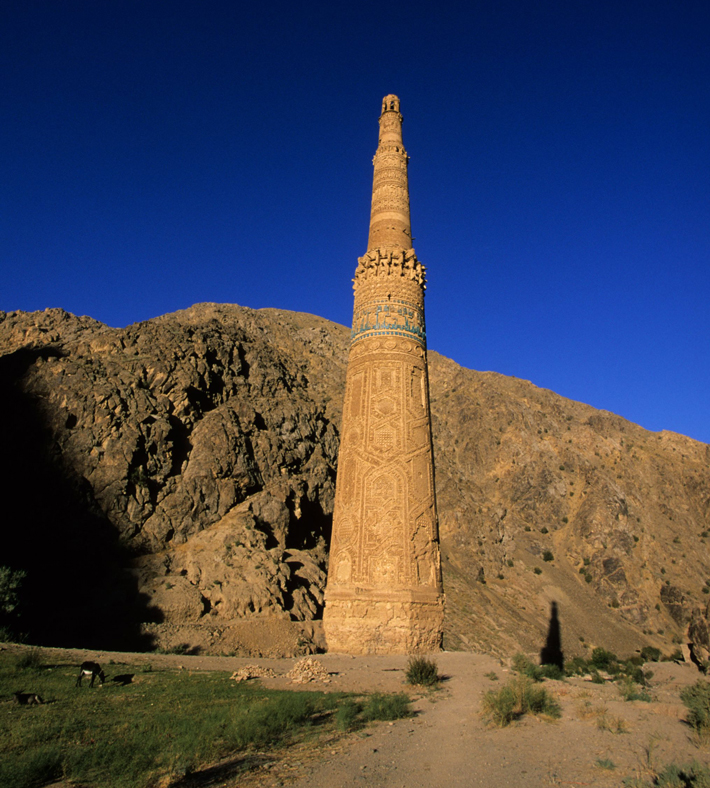 In the remote province of Ghur in western Afghanistan, the Hari and Jam Rivers meet in a narrow valley where mountains tower 7,000 feet high over a seemingly impassable landscape. Far from any urban center, this valley is home to one of the world’s great architectural monuments—a 200-foot-high minaret rising above the valley floor in what seems to be splendid isolation. Built in 1174 of baked brick, the Minaret of Jam is covered in intricate geometric brickwork, with verses of the Koran rendered in blue-glazed tiles. It is one of the few surviving buildings commissioned by the Ghurid sultans, a seasonally nomadic dynasty that, from 1148 to 1215, ruled an empire that at one point stretched from eastern Iran to the Bay of Bengal. “They are like a flare that burst from nowhere,” says David Thomas, a research associate at La Trobe University and director of the Minaret of Jam Archaeological Project (MJAP). “They knock over previously established dynasties, amass territory all the way to northern India, and then, bang, they are gone again.” Though today they are obscure even to many scholars, the Ghurids had a major impact on the trajectory of history in a region whose inhabitants continue to play a geopolitical role that belies their remote location. The recently published work of MJAP is placing a renewed focus on the Ghurids and providing an opportunity to reassess the history of a little-known people.
In the remote province of Ghur in western Afghanistan, the Hari and Jam Rivers meet in a narrow valley where mountains tower 7,000 feet high over a seemingly impassable landscape. Far from any urban center, this valley is home to one of the world’s great architectural monuments—a 200-foot-high minaret rising above the valley floor in what seems to be splendid isolation. Built in 1174 of baked brick, the Minaret of Jam is covered in intricate geometric brickwork, with verses of the Koran rendered in blue-glazed tiles. It is one of the few surviving buildings commissioned by the Ghurid sultans, a seasonally nomadic dynasty that, from 1148 to 1215, ruled an empire that at one point stretched from eastern Iran to the Bay of Bengal. “They are like a flare that burst from nowhere,” says David Thomas, a research associate at La Trobe University and director of the Minaret of Jam Archaeological Project (MJAP). “They knock over previously established dynasties, amass territory all the way to northern India, and then, bang, they are gone again.” Though today they are obscure even to many scholars, the Ghurids had a major impact on the trajectory of history in a region whose inhabitants continue to play a geopolitical role that belies their remote location. The recently published work of MJAP is placing a renewed focus on the Ghurids and providing an opportunity to reassess the history of a little-known people.
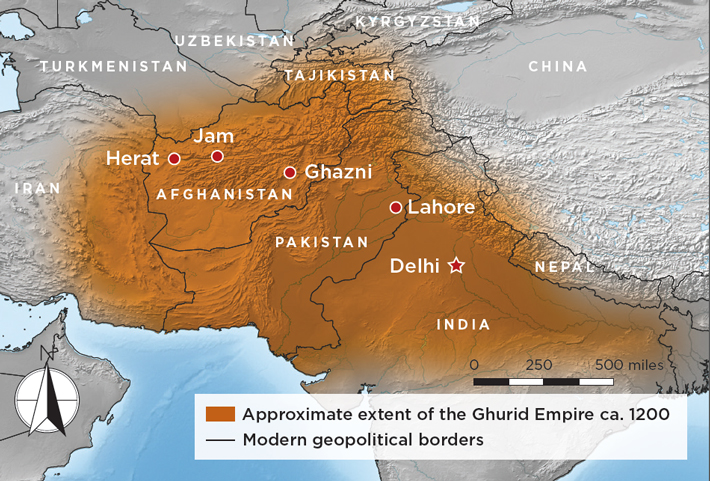 Thomas’ research is based on fieldwork he and his team conducted at Jam in 2003 and 2005. Extensive looting had exposed large areas of archaeological deposits to the elements, and officials tasked MJAP with investigating trenches that had already been illegally dug. The team’s work enabled them to confirm, after many years of speculation, that the site of Jam was Firuzkuh, the Ghurid Dynasty’s summer capital. “When you look at the site, it seems there is nothing there apart from the minaret,” says Thomas. “But we’ve been able to marry together archaeological evidence and historical accounts that show this is Firuzkuh, and it gives us new insights into what a medieval nomadic capital looked like.” The site has been inaccessible to researchers since MJAP’s initial work, but Google Earth’s aerial imagery has given Thomas the chance to identify additional possible Ghurid-period sites in the area, and to put Jam in a larger regional context. Analysis of artifacts and samples from the looters’ holes has also given the team a compelling, if still incomplete, picture of life in the Ghurid summer capital, whose international reach and flourishing economy suggest this narrow valley in remote Afghanistan was once an important center. “It’s not what we would expect a capital city to be like today,” says Thomas. “But it can tell us a lot about who the Ghurids were, and how they thought about power.”
Thomas’ research is based on fieldwork he and his team conducted at Jam in 2003 and 2005. Extensive looting had exposed large areas of archaeological deposits to the elements, and officials tasked MJAP with investigating trenches that had already been illegally dug. The team’s work enabled them to confirm, after many years of speculation, that the site of Jam was Firuzkuh, the Ghurid Dynasty’s summer capital. “When you look at the site, it seems there is nothing there apart from the minaret,” says Thomas. “But we’ve been able to marry together archaeological evidence and historical accounts that show this is Firuzkuh, and it gives us new insights into what a medieval nomadic capital looked like.” The site has been inaccessible to researchers since MJAP’s initial work, but Google Earth’s aerial imagery has given Thomas the chance to identify additional possible Ghurid-period sites in the area, and to put Jam in a larger regional context. Analysis of artifacts and samples from the looters’ holes has also given the team a compelling, if still incomplete, picture of life in the Ghurid summer capital, whose international reach and flourishing economy suggest this narrow valley in remote Afghanistan was once an important center. “It’s not what we would expect a capital city to be like today,” says Thomas. “But it can tell us a lot about who the Ghurids were, and how they thought about power.”
World of the Griffin Warrior
By ANDREW CURRY
Monday, August 12, 2019
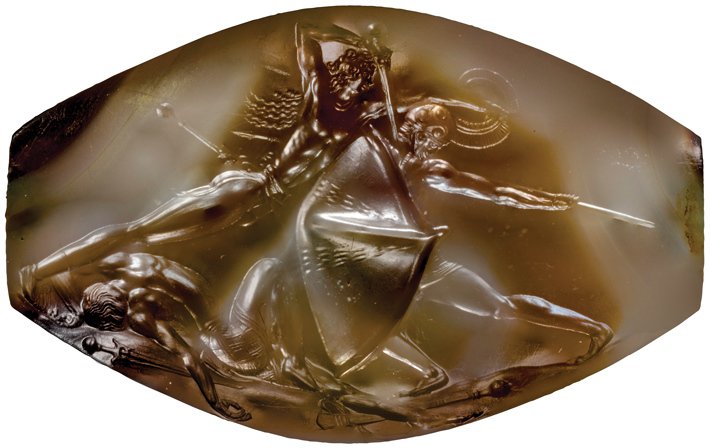 The age of Homer was an age of heroes—Agamemnon, the king of Mycenae, Odysseus, the king of Ithaca, and Nestor, the king of Pylos, among others—whose deeds are chronicled in the Iliad and the Odyssey. Many archaeologists believe that Homer’s tales, despite being composed 500 or more years after the Late Bronze Age events they describe, had roots in a real past. “There’s always a kernel of truth to stories handed down from generation to generation,” says archaeologist Jack Davis. Whether these men were real people is unknown. But the culture they belonged to, which dominated Bronze Age Greece from around 1600 until 1200 B.C.—known as Mycenaean since it was given that name by nineteenth-century scholars—was certainly the model for the poems’ dimly remembered heroes from the deep past.
The age of Homer was an age of heroes—Agamemnon, the king of Mycenae, Odysseus, the king of Ithaca, and Nestor, the king of Pylos, among others—whose deeds are chronicled in the Iliad and the Odyssey. Many archaeologists believe that Homer’s tales, despite being composed 500 or more years after the Late Bronze Age events they describe, had roots in a real past. “There’s always a kernel of truth to stories handed down from generation to generation,” says archaeologist Jack Davis. Whether these men were real people is unknown. But the culture they belonged to, which dominated Bronze Age Greece from around 1600 until 1200 B.C.—known as Mycenaean since it was given that name by nineteenth-century scholars—was certainly the model for the poems’ dimly remembered heroes from the deep past.
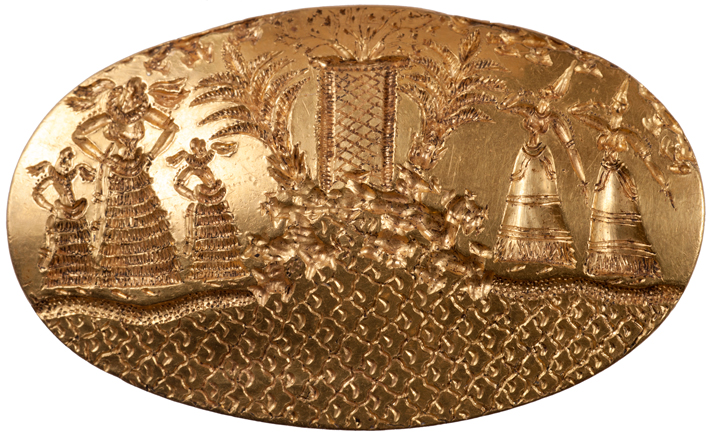
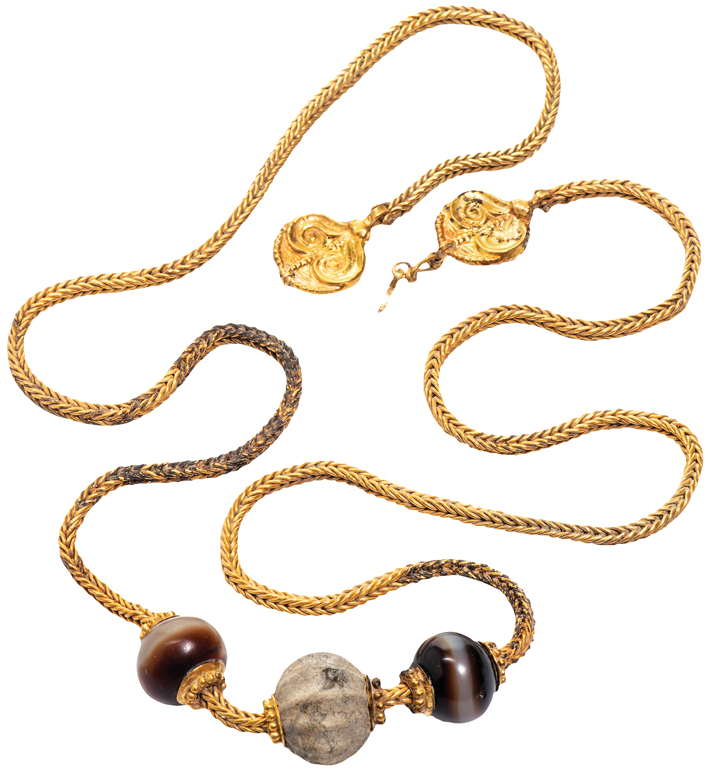 Over the past century, archaeologists and linguists have largely focused their studies on the Mycenaeans’ place in the early development of later classical Greek civilization. Excavations at Pylos, and at sites all across mainland Greece, have provided a great deal of evidence of the Mycenaeans in their prime. This research has revealed that at their peak they were tied into a world that encompassed most of the eastern Mediterranean, including ancient Egypt, the city-states of the Near East, and the islands of the Mediterranean. One such link, though, stands out as perhaps the most important: a deep connection to the island of Crete, which, in the Late Bronze Age, was inhabited by members of a culture scholars call Minoan after the legendary King Minos, a culture very different from that found on the mainland.
Over the past century, archaeologists and linguists have largely focused their studies on the Mycenaeans’ place in the early development of later classical Greek civilization. Excavations at Pylos, and at sites all across mainland Greece, have provided a great deal of evidence of the Mycenaeans in their prime. This research has revealed that at their peak they were tied into a world that encompassed most of the eastern Mediterranean, including ancient Egypt, the city-states of the Near East, and the islands of the Mediterranean. One such link, though, stands out as perhaps the most important: a deep connection to the island of Crete, which, in the Late Bronze Age, was inhabited by members of a culture scholars call Minoan after the legendary King Minos, a culture very different from that found on the mainland.
Scholars have long debated the nature of the relationship between the Mycenaeans and the Minoans. This discussion has centered on whether Mycenaean culture, and what is thought of as ancient Greek culture, dating to half a millennium later, was imported from Crete, or was a homegrown phenomenon. But the exceptional discovery of a man’s grave filled with more than 2,000 artifacts just outside Nestor’s palace in Pylos suggests that the concept of competing cultures might obscure a deep interconnectedness. “Archaeologists have a way of cutting the world up into well-bounded cultural entities, but it seems that in the Late Bronze Age new identities were being formed,” says archaeologist Dimitri Nakassis of the University of Colorado Boulder. “There used to be clear lines between the Minoans and the Mycenaeans, but a lot of work now points out that these are our categories, not theirs.”
|
Slideshow:
|
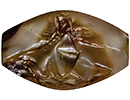
Bronze Age Masterpiece
|
Advertisement
Also in this Issue:
Advertisement
IN THIS ISSUE
From the Trenches
The Case for Clotilda
Off the Grid
A God Goes Shopping
Half in the Bag
Herding Genes in Africa
Bronze Age Palace Surfaces
Upper Paleolithic Cave Life
Scarab From Space
A Catalog of Princes
Sowing the Land
We Are Family
Home on the Plains
Saqqara's Working Stiffs
Inner Beauty
Volcano Viewers
Partially Identified Flying Objects
World Roundup
Egyptian watermelons, a Sumatran tsunami, Siege of Yorktown shipwrecks, and the house of the nine-day queen
Artifact
Just a fleeting impression
Advertisement

Recent Issues
-
 May/June 2024
May/June 2024
-
 March/April 2024
March/April 2024
-
 January/February 2024
January/February 2024
-
 November/December 2023
November/December 2023
-
 September/October 2023
September/October 2023
-
 July/August 2023
July/August 2023
-
 May/June 2023
May/June 2023
-
 March/April 2023
March/April 2023
-
 January/February 2023
January/February 2023
-
 November/December 2022
November/December 2022
-
 September/October 2022
September/October 2022
-
 July/August 2022
July/August 2022
-
 May/June 2022
May/June 2022
-
 March/April 2022
March/April 2022
-
 January/February 2022
January/February 2022
-
 November/December 2021
November/December 2021
-
 September/October 2021
September/October 2021
-
 July/August 2021
July/August 2021
-
 May/June 2021
May/June 2021
-
 March/April 2021
March/April 2021
-
 January/February 2021
January/February 2021
-
 November/December 2020
November/December 2020
-
 September/October 2020
September/October 2020
-
 July/August 2020
July/August 2020
-
 May/June 2020
May/June 2020
-
 March/April 2020
March/April 2020
-
 January/February 2020
January/February 2020
-
 November/December 2019
November/December 2019
-
 September/October 2019
September/October 2019
-
 July/August 2019
July/August 2019
-
 May/June 2019
May/June 2019
-
 March/April 2019
March/April 2019
-
 January/February 2019
January/February 2019
-
 November/December 2018
November/December 2018
-
 September/October 2018
September/October 2018
-
 July/August 2018
July/August 2018
-
 May/June 2018
May/June 2018
-
 March/April 2018
March/April 2018
-
 January/February 2018
January/February 2018
-
 November/December 2017
November/December 2017
-
 September/October 2017
September/October 2017
-
 July/August 2017
July/August 2017
-
 May/June 2017
May/June 2017
-
 March/April 2017
March/April 2017
-
 January/February 2017
January/February 2017
-
 November/December 2016
November/December 2016
-
 September/October 2016
September/October 2016
-
 July/August 2016
July/August 2016
-
 May/June 2016
May/June 2016
-
 March/April 2016
March/April 2016
-
 January/February 2016
January/February 2016
-
 November/December 2015
November/December 2015
-
 September/October 2015
September/October 2015
-
 July/August 2015
July/August 2015
-
 May/June 2015
May/June 2015
-
 March/April 2015
March/April 2015
-
 January/February 2015
January/February 2015
-
 November/December 2014
November/December 2014
-
 September/October 2014
September/October 2014
-
 July/August 2014
July/August 2014
-
 May/June 2014
May/June 2014
-
 March/April 2014
March/April 2014
-
 January/February 2014
January/February 2014
-
 November/December 2013
November/December 2013
-
 September/October 2013
September/October 2013
-
 July/August 2013
July/August 2013
-
 May/June 2013
May/June 2013
-
 March/April 2013
March/April 2013
-
 January/February 2013
January/February 2013
-
 November/December 2012
November/December 2012
-
 September/October 2012
September/October 2012
-
 July/August 2012
July/August 2012
-
 May/June 2012
May/June 2012
-
 March/April 2012
March/April 2012
-
 January/February 2012
January/February 2012
-
 November/December 2011
November/December 2011
-
 September/October 2011
September/October 2011
-
 July/August 2011
July/August 2011
-
 May/June 2011
May/June 2011
-
 March/April 2011
March/April 2011
-
 January/February 2011
January/February 2011
Advertisement





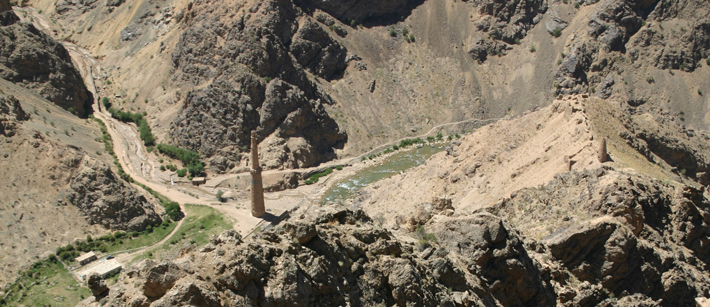 After the Arab conquest of Central Asia began in the seventh century, most Persian-speaking and nomadic Turkic-speaking peoples in the area quickly converted to Islam. One notable exception were the pagan inhabitants of Ghur. Medieval Islamic sources describe them as hardy mountain folk who spoke a dialect of Persian and lived in isolation on the eastern edge of the Islamic and Persian worlds in the largest non-Muslim enclave in the Islamic world. By the eleventh century, however, a Turkic dynasty known as the Ghaznavids had managed to bring Ghur to heel. Islamic missionaries ventured into the mountains and converted the Ghurids. By the 1140s, the power of the Ghaznavids was on the wane, and an upstart branch of Ghurids from the Shansabanid tribe came to prominence. In 1148, a Shansabanid sultan led an army against the Ghaznavid capital of Ghazni, putting the city to fire and earning the sobriquet “World Burner.” From there, the Ghurids expanded east and west, eventually establishing secondary capitals in the then-obscure city of Delhi on the northern Indian plain, and in the cities of Herat, in modern Afghanistan, and Lahore, in present-day Pakistan. Unlike other medieval Islamic dynasties, the Ghurids had corulers, and power was not inherited by descendants, but shared by multiple sultans who set up court in different locations throughout the empire. The senior sultans stayed in the Ghurid heartland, making their summer capital at Firuzkuh. They sponsored a building program that included erecting mosques, mausoleums, and madrassas, or Islamic schools, across what is now Afghanistan.
After the Arab conquest of Central Asia began in the seventh century, most Persian-speaking and nomadic Turkic-speaking peoples in the area quickly converted to Islam. One notable exception were the pagan inhabitants of Ghur. Medieval Islamic sources describe them as hardy mountain folk who spoke a dialect of Persian and lived in isolation on the eastern edge of the Islamic and Persian worlds in the largest non-Muslim enclave in the Islamic world. By the eleventh century, however, a Turkic dynasty known as the Ghaznavids had managed to bring Ghur to heel. Islamic missionaries ventured into the mountains and converted the Ghurids. By the 1140s, the power of the Ghaznavids was on the wane, and an upstart branch of Ghurids from the Shansabanid tribe came to prominence. In 1148, a Shansabanid sultan led an army against the Ghaznavid capital of Ghazni, putting the city to fire and earning the sobriquet “World Burner.” From there, the Ghurids expanded east and west, eventually establishing secondary capitals in the then-obscure city of Delhi on the northern Indian plain, and in the cities of Herat, in modern Afghanistan, and Lahore, in present-day Pakistan. Unlike other medieval Islamic dynasties, the Ghurids had corulers, and power was not inherited by descendants, but shared by multiple sultans who set up court in different locations throughout the empire. The senior sultans stayed in the Ghurid heartland, making their summer capital at Firuzkuh. They sponsored a building program that included erecting mosques, mausoleums, and madrassas, or Islamic schools, across what is now Afghanistan.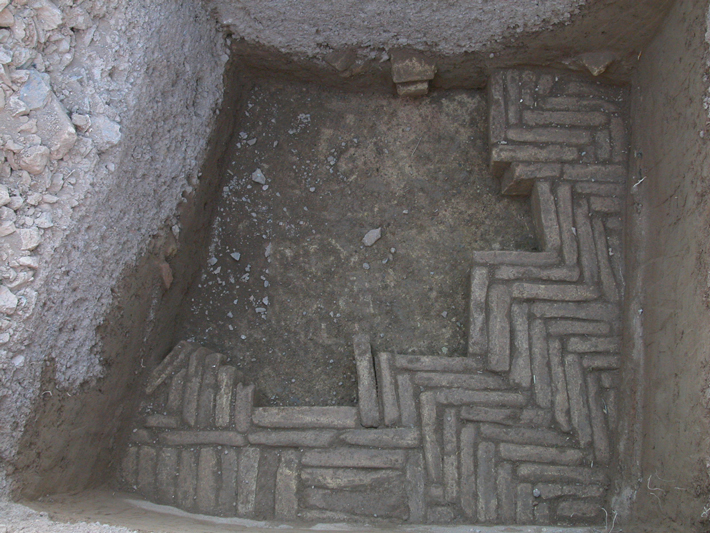 There they quickly made a discovery that they believe has definitively established that Jam was the summer capital of Firuzkuh. Historical sources recorded that a great flood destroyed a mosque at Firuzkuh around 1200. In a series of holes close to the tower, Thomas and his team discovered the remains of a large brick-paved courtyard that had been covered by river sediment in a single catastrophic event. “It was clear from the stratigraphy that layers of mud and gravel had been deposited by floodwater,” says Thomas. “There was no question that we had evidence for this historical event, making it almost certain the Minaret of Jam was once part of the Firuzkuh mosque.” Thomas notes that, while historical sources do briefly refer to the mosque itself, they make no mention of the minaret. “It’s almost as if, back in the day, a magnificent tower like this was not out of the ordinary. It was just a typical part of the architectural landscape,” says Thomas. “We know there were towers in other Ghurid centers, so chroniclers may just have not considered it remarkable enough to describe.” Reports of a tall tower in the area were first noted in the late nineteenth century by British surveyors, but they were unable to go to the site. In the 1950s, a Belgian archaeologist, acting on a tip from an Afghan historian, visited the tower and publicized it widely.
There they quickly made a discovery that they believe has definitively established that Jam was the summer capital of Firuzkuh. Historical sources recorded that a great flood destroyed a mosque at Firuzkuh around 1200. In a series of holes close to the tower, Thomas and his team discovered the remains of a large brick-paved courtyard that had been covered by river sediment in a single catastrophic event. “It was clear from the stratigraphy that layers of mud and gravel had been deposited by floodwater,” says Thomas. “There was no question that we had evidence for this historical event, making it almost certain the Minaret of Jam was once part of the Firuzkuh mosque.” Thomas notes that, while historical sources do briefly refer to the mosque itself, they make no mention of the minaret. “It’s almost as if, back in the day, a magnificent tower like this was not out of the ordinary. It was just a typical part of the architectural landscape,” says Thomas. “We know there were towers in other Ghurid centers, so chroniclers may just have not considered it remarkable enough to describe.” Reports of a tall tower in the area were first noted in the late nineteenth century by British surveyors, but they were unable to go to the site. In the 1950s, a Belgian archaeologist, acting on a tip from an Afghan historian, visited the tower and publicized it widely.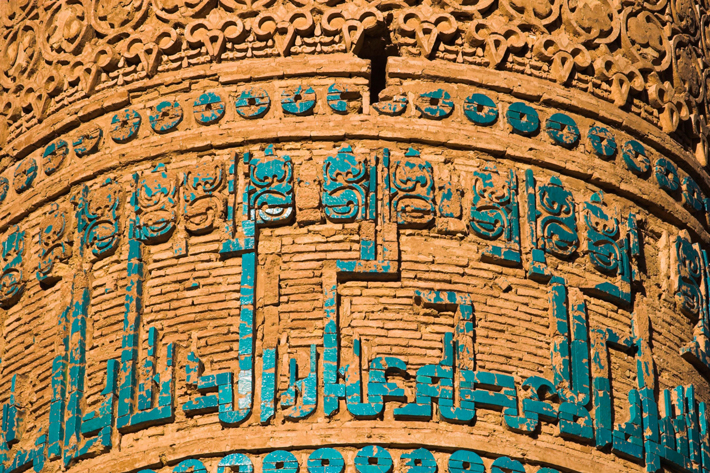 The Ghurids and their contemporaries often erected towers to commemorate important victories, and it’s possible that the Minaret of Jam was raised to celebrate a military triumph over the Ghaznavids or some other adversary. However, some researchers, including Thomas, believe there may have been a different inspiration behind the construction of the minaret. The main theme of the Koranic verses that decorate the minaret is Mary, the mother of Jesus, who is revered in Islam. There is evidence that a powerful woman in the Ghurid Dynasty commissioned a madrassa to the north of Jam, whose ruins still stand. Given the Minaret of Jam’s emphasis of verses on Mary, perhaps a noblewoman was also responsible for commissioning the tower.
The Ghurids and their contemporaries often erected towers to commemorate important victories, and it’s possible that the Minaret of Jam was raised to celebrate a military triumph over the Ghaznavids or some other adversary. However, some researchers, including Thomas, believe there may have been a different inspiration behind the construction of the minaret. The main theme of the Koranic verses that decorate the minaret is Mary, the mother of Jesus, who is revered in Islam. There is evidence that a powerful woman in the Ghurid Dynasty commissioned a madrassa to the north of Jam, whose ruins still stand. Given the Minaret of Jam’s emphasis of verses on Mary, perhaps a noblewoman was also responsible for commissioning the tower.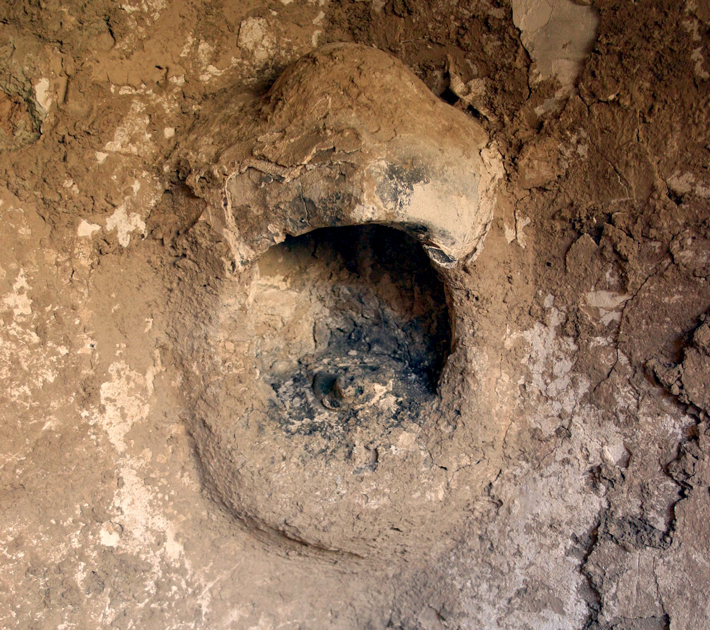 Thomas and his team excavated a series of other looters’ holes located throughout the site to get a sense of how complex the capital was. They found one looters’ hole dug into the middle of a substantial mudbrick house. A niche in the side of the structure still had an oil lamp that had been placed there more than 800 years earlier. “We think there were people in residence at the site year-round, despite the fact that the sultans were only here in the summer,” says Thomas. “It would not have been very hospitable in the winter, but we think there was perhaps a caretaker population that watched over the capital in winter.”
Thomas and his team excavated a series of other looters’ holes located throughout the site to get a sense of how complex the capital was. They found one looters’ hole dug into the middle of a substantial mudbrick house. A niche in the side of the structure still had an oil lamp that had been placed there more than 800 years earlier. “We think there were people in residence at the site year-round, despite the fact that the sultans were only here in the summer,” says Thomas. “It would not have been very hospitable in the winter, but we think there was perhaps a caretaker population that watched over the capital in winter.”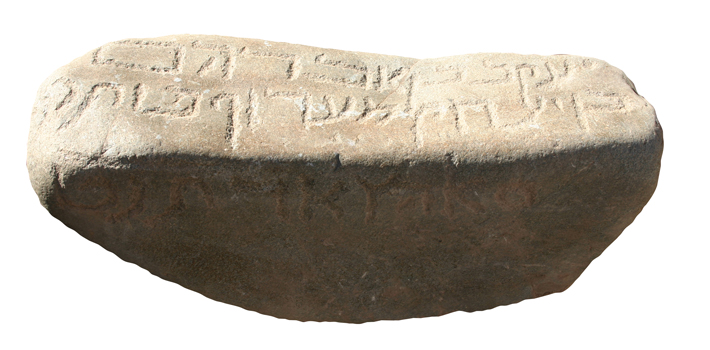 Thomas and his team identified four Jewish headstones, which added to a collection of more than 70 that had been found by Italian researchers in the 1960s. All but six of the headstones recovered thus far memorialize men who lived between 1150 and 1220, the historically recorded period of occupation in Firuzkuh. That there are no headstones from the cemetery belonging to Jewish women suggests to Thomas and his colleagues that the men likely came to the capital without families, and perhaps married local non-Jewish women. The professions listed on the gravestones include goldsmith, teacher, and religious specialist, in addition to more workaday trades. Along with the dates on the gravestones, this suggests a long-lived community had put down roots at Firuzkuh and occupied the town year-round.
Thomas and his team identified four Jewish headstones, which added to a collection of more than 70 that had been found by Italian researchers in the 1960s. All but six of the headstones recovered thus far memorialize men who lived between 1150 and 1220, the historically recorded period of occupation in Firuzkuh. That there are no headstones from the cemetery belonging to Jewish women suggests to Thomas and his colleagues that the men likely came to the capital without families, and perhaps married local non-Jewish women. The professions listed on the gravestones include goldsmith, teacher, and religious specialist, in addition to more workaday trades. Along with the dates on the gravestones, this suggests a long-lived community had put down roots at Firuzkuh and occupied the town year-round.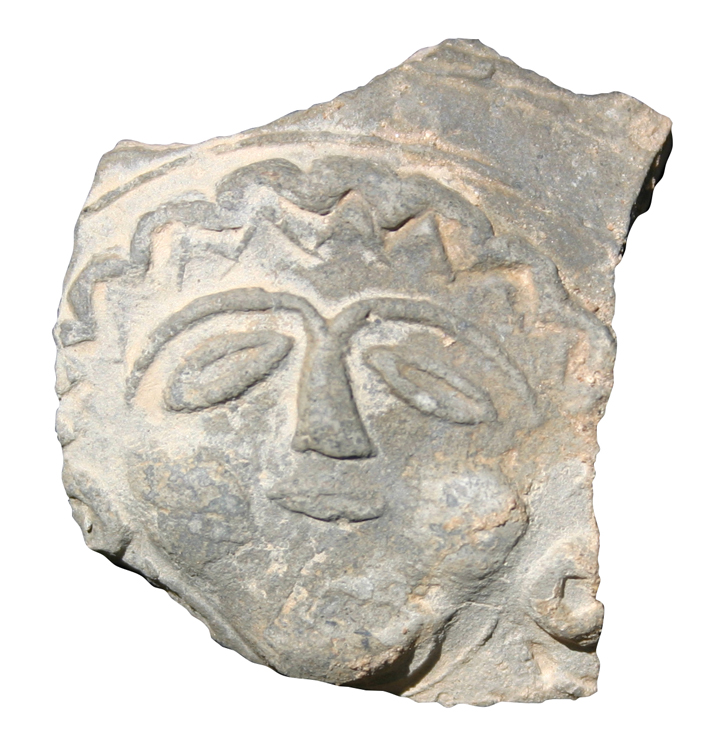 In addition, the variety of ceramics recovered from the site show that the prosperous capital was part of a far-flung trade network. Gascoigne, MJAP’s pottery expert, identified fine ware not only from Iran, but also from China. “It’s interesting to see how the population in this incredibly remote area was provisioned,” she says. “Some of this pottery had come a very long way.” The team also found elaborately molded water jars, one of which featured a humorous depiction of a smiling, puffy-cheeked individual. Some of the pottery they collected could have been produced on-site. The team identified the remains of an industrial-sized kiln to the south of the settlement that may have been used to fire pottery, but they were unable to study it in detail. Surrounding the capital was a complex system of mudbrick fortifications, much of which seems to have been designed without an external threat in mind.
In addition, the variety of ceramics recovered from the site show that the prosperous capital was part of a far-flung trade network. Gascoigne, MJAP’s pottery expert, identified fine ware not only from Iran, but also from China. “It’s interesting to see how the population in this incredibly remote area was provisioned,” she says. “Some of this pottery had come a very long way.” The team also found elaborately molded water jars, one of which featured a humorous depiction of a smiling, puffy-cheeked individual. Some of the pottery they collected could have been produced on-site. The team identified the remains of an industrial-sized kiln to the south of the settlement that may have been used to fire pottery, but they were unable to study it in detail. Surrounding the capital was a complex system of mudbrick fortifications, much of which seems to have been designed without an external threat in mind.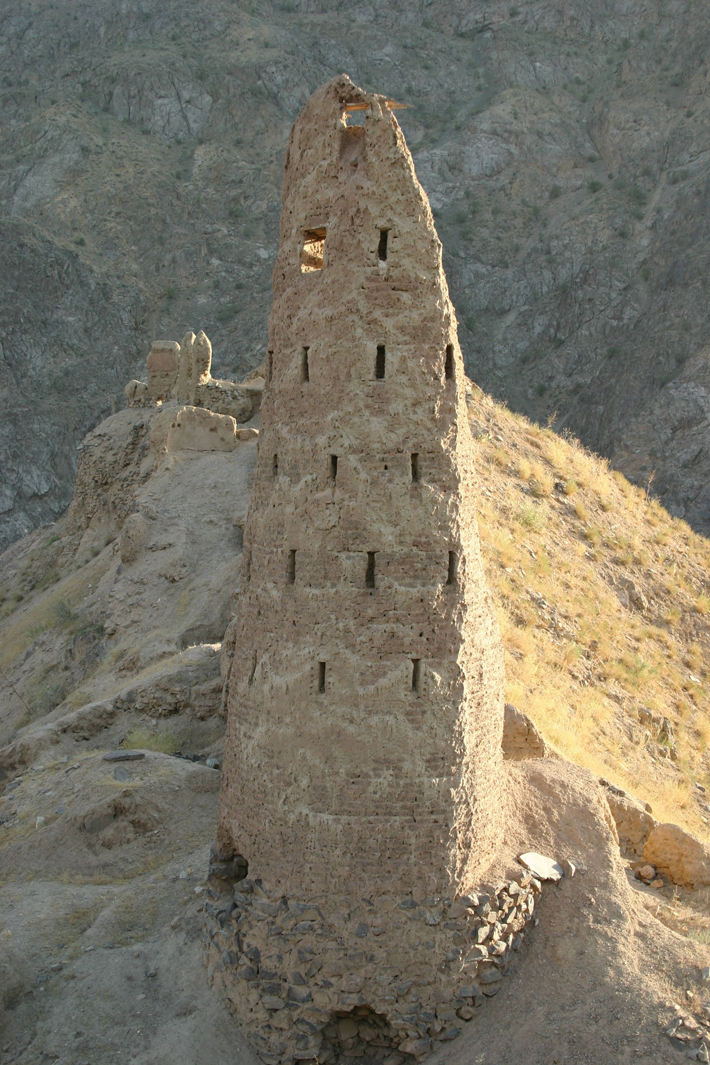 Thomas analyzed the views from the still-extant towers, and found that most of them did not command vistas that extended beyond the valley. Rather, many of the towers seem to have been constructed to conduct surveillance of the valley itself. Thomas speculates that the fortifications might have been built in the wake of the religious riots that swept Firuzkuh toward the end of the Ghurid Dynasty’s reign. It’s possible that even after the Ghurid sultan Ghiyath al-Din quit the remote summer capital for Herat, he wanted to keep an eye on his rebellious subjects in Firuzkuh. A network of fortifications intended to monitor threats inside the capital, rather than approaching foes, might have been a result of his concern. The sultan was perhaps right to be preoccupied with the possibility of internal instability. His successor was assassinated in 1215, an event that led to the collapse of the Ghurid Empire. It had lasted less than 70 years in all.
Thomas analyzed the views from the still-extant towers, and found that most of them did not command vistas that extended beyond the valley. Rather, many of the towers seem to have been constructed to conduct surveillance of the valley itself. Thomas speculates that the fortifications might have been built in the wake of the religious riots that swept Firuzkuh toward the end of the Ghurid Dynasty’s reign. It’s possible that even after the Ghurid sultan Ghiyath al-Din quit the remote summer capital for Herat, he wanted to keep an eye on his rebellious subjects in Firuzkuh. A network of fortifications intended to monitor threats inside the capital, rather than approaching foes, might have been a result of his concern. The sultan was perhaps right to be preoccupied with the possibility of internal instability. His successor was assassinated in 1215, an event that led to the collapse of the Ghurid Empire. It had lasted less than 70 years in all.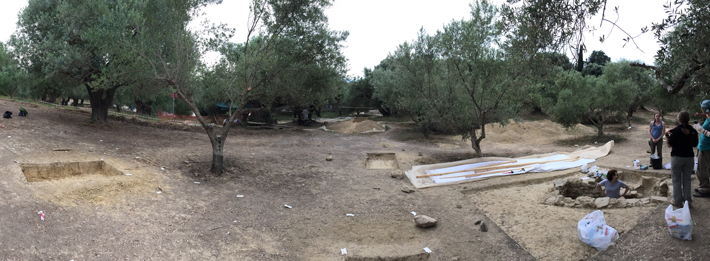
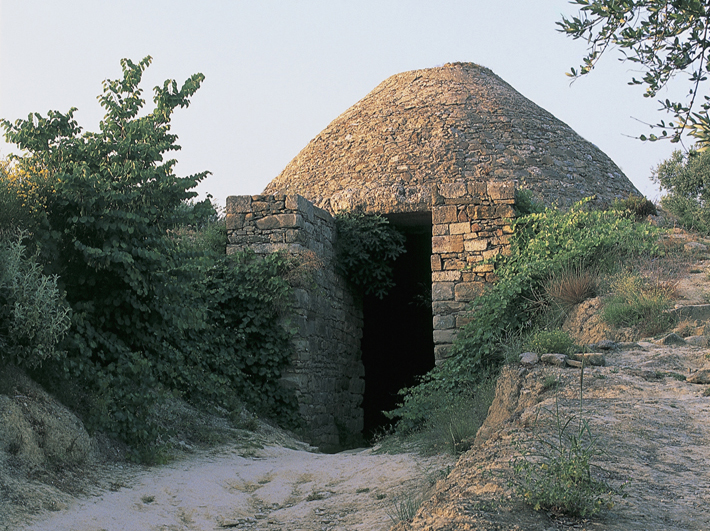 The extraordinary contents of this man’s grave may be the key to understanding a far more complex development. Scholars are now beginning to believe that the shift from the Minoan to Mycenaean world may not have been a sharp transition achieved through colonization or conquest, but a more complicated process of cultural mixture and communication that only came to an end when mainland Mycenaean culture took over Crete around 1400 B.C. Says Jan Driessen, a Minoan specialist at the Catholic University of Louvain, “There’s no way to overestimate the tomb’s importance.”
The extraordinary contents of this man’s grave may be the key to understanding a far more complex development. Scholars are now beginning to believe that the shift from the Minoan to Mycenaean world may not have been a sharp transition achieved through colonization or conquest, but a more complicated process of cultural mixture and communication that only came to an end when mainland Mycenaean culture took over Crete around 1400 B.C. Says Jan Driessen, a Minoan specialist at the Catholic University of Louvain, “There’s no way to overestimate the tomb’s importance.”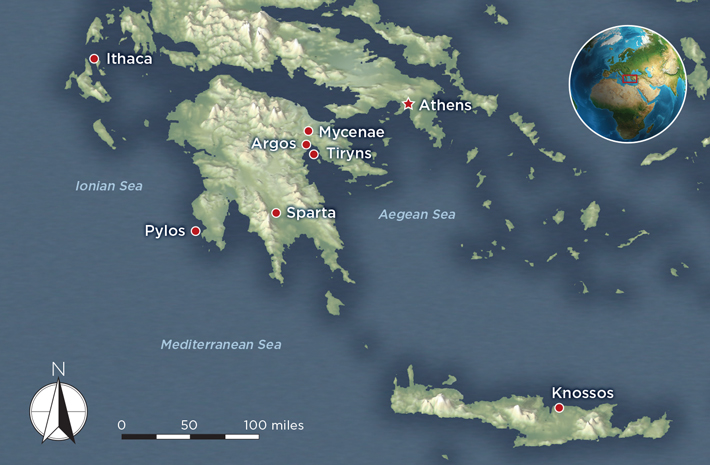 Legal delays meant the team wasn’t able to excavate where they had originally planned. “Forty people showed up, and we had nowhere to dig,” says Stocker. Thwarted, they began investigating a stone formation nestled among the olive trees that surround the palace. Although the site was just over 200 yards from the palace’s front gate, Davis says he didn’t have high hopes for the area. He thought it might be the foundation of one of the palace’s outbuildings, or a water storage tank.
Legal delays meant the team wasn’t able to excavate where they had originally planned. “Forty people showed up, and we had nowhere to dig,” says Stocker. Thwarted, they began investigating a stone formation nestled among the olive trees that surround the palace. Although the site was just over 200 yards from the palace’s front gate, Davis says he didn’t have high hopes for the area. He thought it might be the foundation of one of the palace’s outbuildings, or a water storage tank.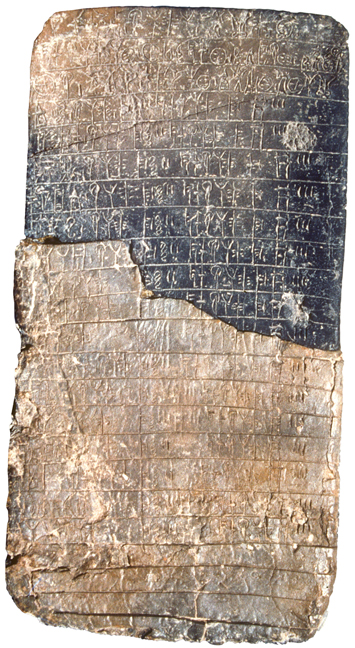 The warrior’s solo shaft burial was unusual for his time. Most contemporary Mycenaeans were interred in shared graves, sometimes with up to 20 people in a single grave or tholos. The tombs were periodically reopened and the human remains separated and shuffled around with each new addition to the family crypt. This has made it difficult for archaeologists to distinguish which artifacts were buried with whom. “What’s surprising in the case of the Griffin Warrior is to find a complete example where you know exactly what was deposited with this individual,” says archaeologist John Bennet, director of the British School at Athens.
The warrior’s solo shaft burial was unusual for his time. Most contemporary Mycenaeans were interred in shared graves, sometimes with up to 20 people in a single grave or tholos. The tombs were periodically reopened and the human remains separated and shuffled around with each new addition to the family crypt. This has made it difficult for archaeologists to distinguish which artifacts were buried with whom. “What’s surprising in the case of the Griffin Warrior is to find a complete example where you know exactly what was deposited with this individual,” says archaeologist John Bennet, director of the British School at Athens.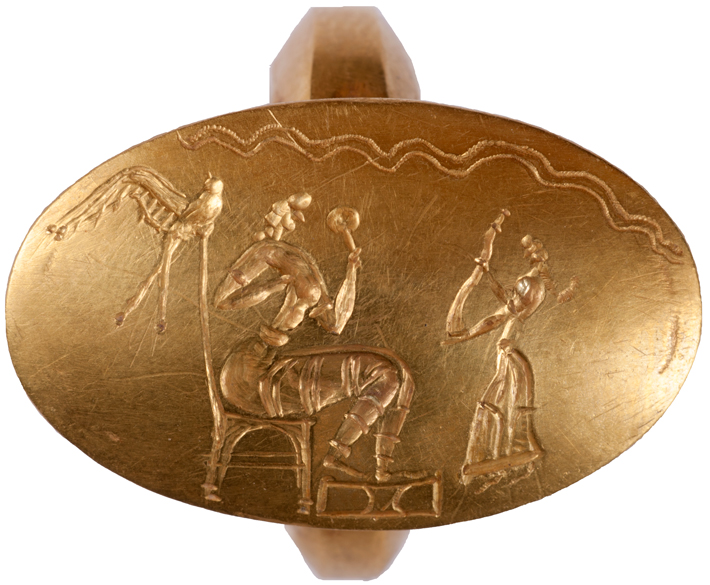 Nearly 150 years of archaeological excavations on the Greek mainland and Crete have shown that, beginning around 1600 B.C., the comparatively unsophisticated culture on the mainland underwent a radical transformation. “In time, there’s a blossoming of wealth and culture,” Stocker says. “Palaces are built, wealth accumulates, and power is consolidated in places such as Pylos and Mycenae.” The reasons for this leap forward are unknown. For a few centuries, the mainlanders imitated the Minoans. Pylos was an early Mycenaean power center, and buildings there at the time of the Griffin Warrior resembled the large houses with ashlar masonry found at Knossos on Crete. “There were probably four or five fancy mansions in Pylos at the time of the Griffin Warrior, all very Minoan in style,” Davis says. For example, the mansions had painted walls, a type of artistry pioneered by the Minoans.
Nearly 150 years of archaeological excavations on the Greek mainland and Crete have shown that, beginning around 1600 B.C., the comparatively unsophisticated culture on the mainland underwent a radical transformation. “In time, there’s a blossoming of wealth and culture,” Stocker says. “Palaces are built, wealth accumulates, and power is consolidated in places such as Pylos and Mycenae.” The reasons for this leap forward are unknown. For a few centuries, the mainlanders imitated the Minoans. Pylos was an early Mycenaean power center, and buildings there at the time of the Griffin Warrior resembled the large houses with ashlar masonry found at Knossos on Crete. “There were probably four or five fancy mansions in Pylos at the time of the Griffin Warrior, all very Minoan in style,” Davis says. For example, the mansions had painted walls, a type of artistry pioneered by the Minoans.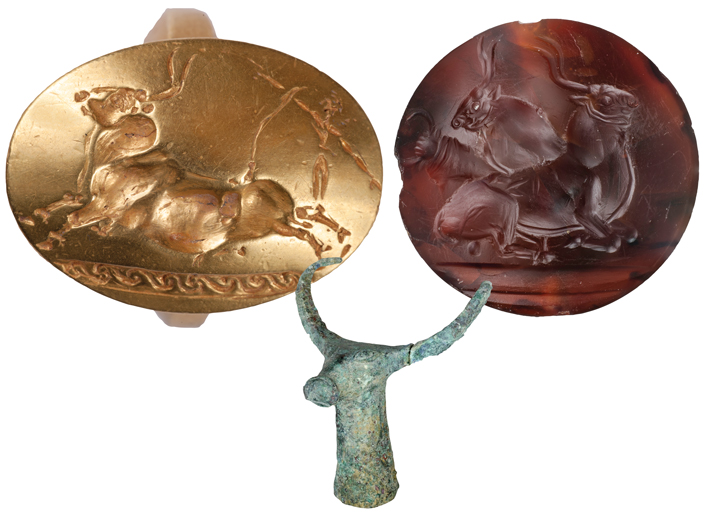
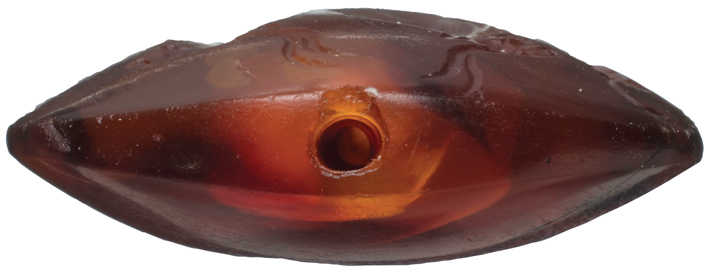 For a time, the Mycenaeans both imported Minoan luxury goods and incorporated Minoan symbols, including the bull, into their own art. The richest Mycenaeans were buried with Minoan luxury goods, while some other graves included locally produced Mycenaean objects, such as painted pottery, that were often excellent-quality copies of Minoan originals. The Mycenaeans also borrowed the Minoan script, called Linear A, and adapted it to their own use; this script is now called Linear B. Mycenaean society, too, began to change shape. What began as a loose collection of small villages became more and more hierarchical, with power concentrated in the hands of the palace-dwelling members of society featured in the works of Homer.
For a time, the Mycenaeans both imported Minoan luxury goods and incorporated Minoan symbols, including the bull, into their own art. The richest Mycenaeans were buried with Minoan luxury goods, while some other graves included locally produced Mycenaean objects, such as painted pottery, that were often excellent-quality copies of Minoan originals. The Mycenaeans also borrowed the Minoan script, called Linear A, and adapted it to their own use; this script is now called Linear B. Mycenaean society, too, began to change shape. What began as a loose collection of small villages became more and more hierarchical, with power concentrated in the hands of the palace-dwelling members of society featured in the works of Homer.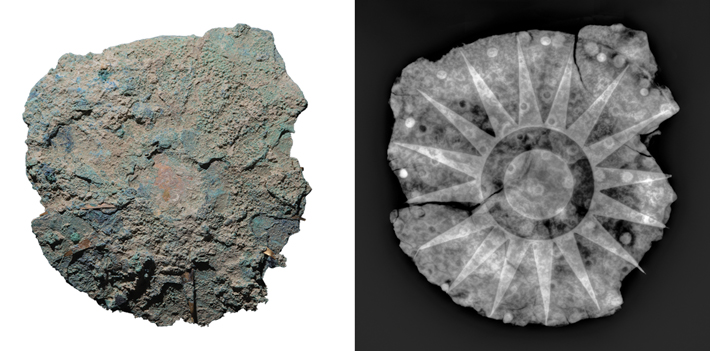
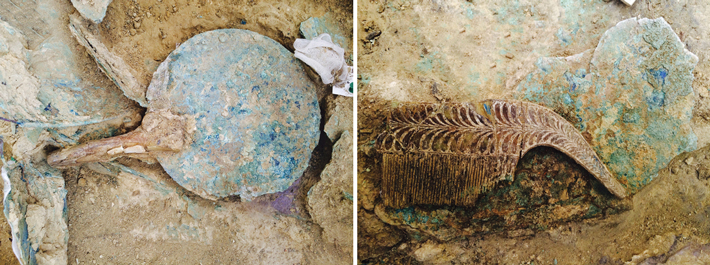 Half a century later, that interpretation was upended. When clay tablets found at Pylos and other sites, including Mycenae, were deciphered in the 1950s, the story was pushed in a completely different direction. Linear B resembled Crete’s Linear A, but recorded an entirely different language—Mycenaean Greek. It became clear that it was related to the language of the Iliad and the Odyssey, and, more distantly, to the other Indo-European languages, from Sanskrit to English. Scholars today can peruse the bureaucratic records left behind in the Palace of Nestor, while Linear A and the language it records remain an impenetrable mystery.
Half a century later, that interpretation was upended. When clay tablets found at Pylos and other sites, including Mycenae, were deciphered in the 1950s, the story was pushed in a completely different direction. Linear B resembled Crete’s Linear A, but recorded an entirely different language—Mycenaean Greek. It became clear that it was related to the language of the Iliad and the Odyssey, and, more distantly, to the other Indo-European languages, from Sanskrit to English. Scholars today can peruse the bureaucratic records left behind in the Palace of Nestor, while Linear A and the language it records remain an impenetrable mystery.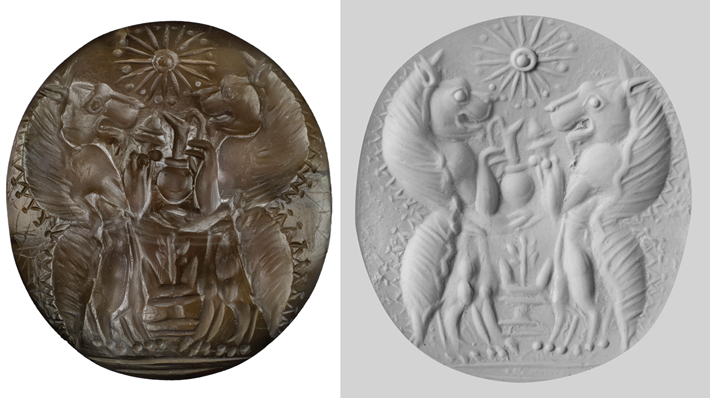
 One notable category of objects buried with the Griffin Warrior is seal stones—some 50 of them, made of semiprecious materials. The seal stones, originally used by the Minoans for administrative purposes, are miniature works of art, intricately decorated beyond any functional necessity. In fact, after the stones were cleaned and restored, Stocker’s colleagues made impressions of their designs in putty and found that some of the detail is too small to see with the naked eye, even in the imprints. Many of the stones had been placed on the warrior’s right side, some probably worn as part of bracelets, and others gathered in a bag or pouch that decayed long ago. The most spectacular seal stone, dubbed the Pylos Combat Agate, is just 1.4 inches wide. Davis and Stocker believe that the artist who created this seal stone was Cretan, because there is, thus far at least, no evidence that artisans on the mainland possessed the skill required to create such an object. The stone depicts a leaping warrior stabbing an armored, spear-wielding foe, while another lies dead at his feet. The scene, like those on many of the other seal stones, is echoed by artifacts found in the warrior’s grave, such as the weapons and scepter laid on his left side. “The sword the victor is using is the same as the sword the warrior is buried with,” Davis says. Six ivory combs and a mirror in the grave suggest the warrior was concerned with his grooming, and perhaps had flowing locks similar to those of the stone’s triumphant warrior. Like the agate’s hero, the Griffin Warrior wore a gold necklace. There is also a nearly microscopic seal stone, less than two-hundredths of an inch across, depicted on a bracelet on the warrior’s wrist. The seal stones in the grave were drilled through, as though to accommodate just such a bracelet cord.
One notable category of objects buried with the Griffin Warrior is seal stones—some 50 of them, made of semiprecious materials. The seal stones, originally used by the Minoans for administrative purposes, are miniature works of art, intricately decorated beyond any functional necessity. In fact, after the stones were cleaned and restored, Stocker’s colleagues made impressions of their designs in putty and found that some of the detail is too small to see with the naked eye, even in the imprints. Many of the stones had been placed on the warrior’s right side, some probably worn as part of bracelets, and others gathered in a bag or pouch that decayed long ago. The most spectacular seal stone, dubbed the Pylos Combat Agate, is just 1.4 inches wide. Davis and Stocker believe that the artist who created this seal stone was Cretan, because there is, thus far at least, no evidence that artisans on the mainland possessed the skill required to create such an object. The stone depicts a leaping warrior stabbing an armored, spear-wielding foe, while another lies dead at his feet. The scene, like those on many of the other seal stones, is echoed by artifacts found in the warrior’s grave, such as the weapons and scepter laid on his left side. “The sword the victor is using is the same as the sword the warrior is buried with,” Davis says. Six ivory combs and a mirror in the grave suggest the warrior was concerned with his grooming, and perhaps had flowing locks similar to those of the stone’s triumphant warrior. Like the agate’s hero, the Griffin Warrior wore a gold necklace. There is also a nearly microscopic seal stone, less than two-hundredths of an inch across, depicted on a bracelet on the warrior’s wrist. The seal stones in the grave were drilled through, as though to accommodate just such a bracelet cord.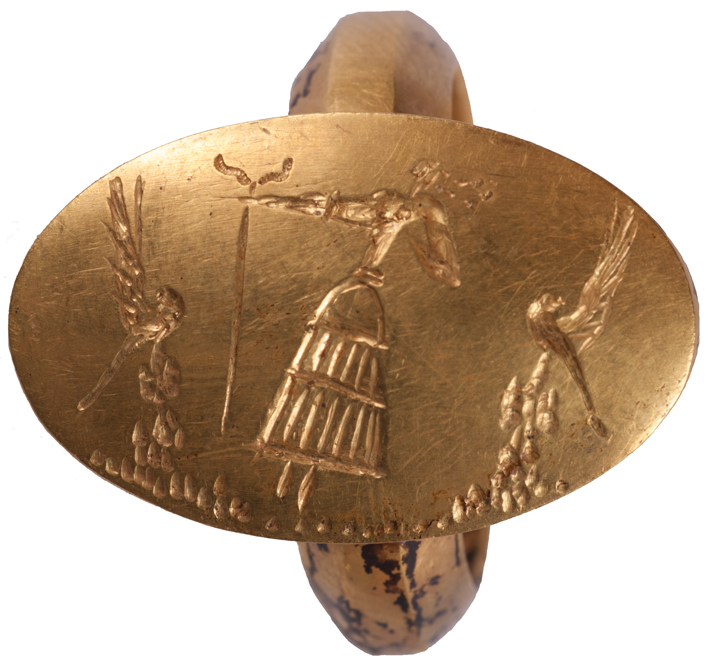 The sheer number of carved rings and seal stones reinforces the idea that there was something more than mimicry going on. Driessen says seal stones such as those found in the Griffin Warrior’s tomb were highly individual objects that were used by the Minoans for bureaucratic functions, such as to signal identity on official documents. A Minoan would have had one ring or seal stone, or maybe two—but not 50. “It doesn’t make sense to have fifty seal stones,” Driessen says. “The Griffin Warrior was showing off, or maybe the ones who buried him were showing off. There’s obviously Minoan influence, but I do think some of these objects were not used in the same way the Minoans used them.”
The sheer number of carved rings and seal stones reinforces the idea that there was something more than mimicry going on. Driessen says seal stones such as those found in the Griffin Warrior’s tomb were highly individual objects that were used by the Minoans for bureaucratic functions, such as to signal identity on official documents. A Minoan would have had one ring or seal stone, or maybe two—but not 50. “It doesn’t make sense to have fifty seal stones,” Driessen says. “The Griffin Warrior was showing off, or maybe the ones who buried him were showing off. There’s obviously Minoan influence, but I do think some of these objects were not used in the same way the Minoans used them.”
